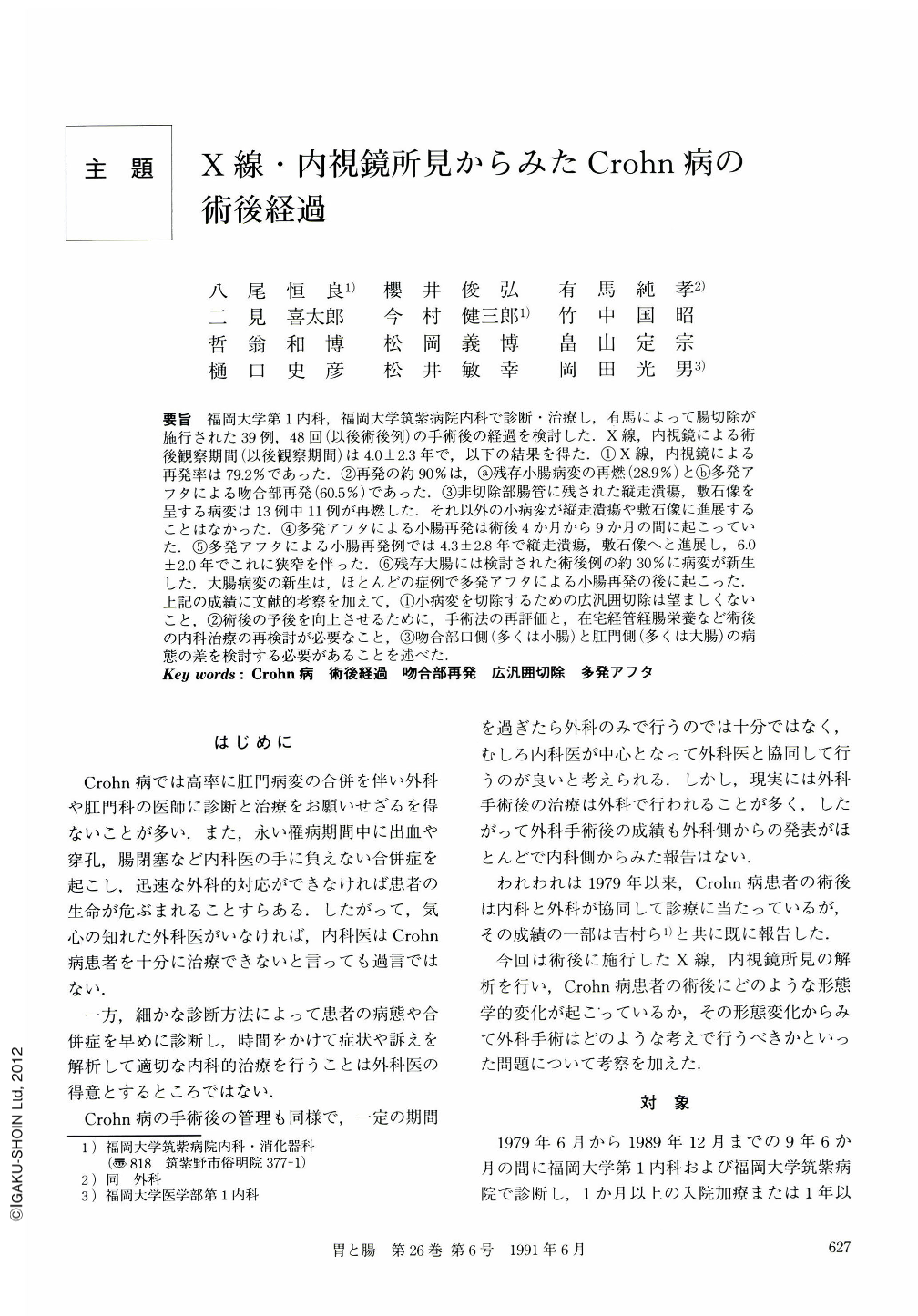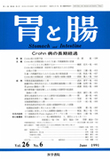Japanese
English
- 有料閲覧
- Abstract 文献概要
- 1ページ目 Look Inside
- サイト内被引用 Cited by
要旨 福岡大学第1内科,福岡大学筑紫病院内科で診断・治療し,有馬によって腸切除が施行された39例,48回(以後術後例)の手術後の経過を検討した.X線,内視鏡による術後観察期間(以後観察期間)は4.0±2.3年で,以下の結果を得た.①X線,内視鏡による再発率は79.2%であった.②再発の約90%は,(a)残存小腸病変の再燃(28.9%)と(b)多発アフタによる吻合部再発(60.5%)であった.③非切除部腸管に残された縦走潰瘍,敷石像を呈する病変は13例中11例が再燃した.それ以外の小病変が縦走潰瘍や敷石像に進展することはなかった.④多発アフタによる小腸再発は術後4か月から9か月の間に起こっていた.⑤多発アフタによる小腸再発例では4.3±2.8年で縦走潰瘍,敷石像へと進展し,6.0±2.0年でこれに狭窄を伴った.⑥残存大腸には検討された術後例の約30%に病変が新生した.大腸病変の新生は,ほとんどの症例で多発アフタによる小腸再発の後に起こった.上記の成績に文献的考察を加えて,①小病変を切除するための広汎囲切除は望ましくないこと,②術後の予後を向上させるために,手術法の再評価と,在宅経管経腸栄養など術後の内科治療の再検討が必要なこと,③吻合部口側(多くは小腸)と肛門側(多くは大腸)の病態の差を検討する必要があることを述べた.
Postoperative course of 39 patients with Crohn's disease was studied in a total of 48 operations. Those patients were diagnosed as having Crohn's disease and were treated at the First Department of Internal Medicine of Fukuoka University or at the Department of Internal Medicine of Fukuoka University Chikushi Hospital and were eventually operated on by Arima S M.D., one of the authors. The period of follow-up by radiography and endoscopy was 4.0±2.3 years.
1) Recurrence rate observed by radiography and endoscopy was 79.2%.
2) Approximately 90% of recurrence consisted of (i) recrudescence of remnant lesions of the small bowel (28.9%) and (ii) recurrence of the anastomotic site caused by multiple aphthous lesions (60.5%).
3) Recurrence of longitudinal ulcers and cobblestoning remaining on the non-resected bowel was recognized in 11 of 13 patients.
4) Recurrence caused by multiple aphthous lesions occurred four to nine months after operation.
5) Recurrence by multiple aphthous lesions progressed to longitudinal ulcers and cobblestoning 4.3±2.8 years after operation, and further progressed to lesions having stenosis 6.0±2.0 years after operation.
6) Newly developed lesions were recognized in the large bowel in approximately 30% of the follow-up cases. Those lesions mostly developed after small intestinal recurrence.
From these results and with reference to the literature, concludsion is as follows:
(i) An extensive resection to remove small lesions is not desirable.
(ii) Reevaluation of operative procedures and reestimation of postoperative medical treatment such as home elemental diet are required.
(iii) It is required to study the clinicopathological difference of the proximal site (mostly the small bowel) and the distal site (mostly the large bowel) of the anastomosis.

Copyright © 1991, Igaku-Shoin Ltd. All rights reserved.


